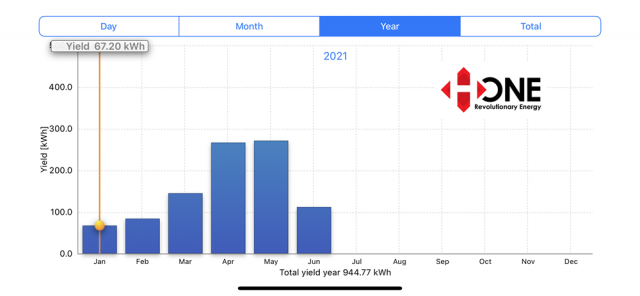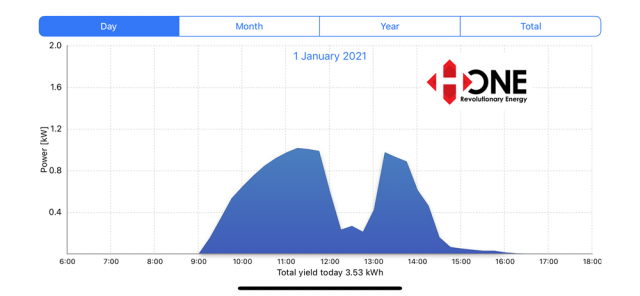This is a real case study.
It is a basic grid-connected electricity installation on a residential home. This means electricity-generating panels are placed on the roof. They are connected via an inverter into the main fuse board. When they are generating electricity, they are slowing or stopping your meter down. In this case, the homeowner has a home office, so instead of turning the central heating system on each day in a large empty house, they now use a smart panel heater in the office instead.
The only important thing you need to figure out is which technology is the best in an industry where everyone claims to be the best.
The proof is the only evidence. The data below from this particular customer installation is 968 kWhr/ KW(peak) installed for 2020. We challenge anyone to beat that result in the same area.
HONE Electric systems get most of their additional performance in Winter when standard Solar PV struggles to produce anything; this is the daylight harvesting effect of HONE, and dark winter cloudy, wet days are where HONE shines.
Have a look at the following LIVE datasets from 2021. The HONE system is 2KW; the standard German Solar PV system is 2.15KW in size.
If you correct the data down to 1 KW (peak) for each system, so you can compare like with like, you can see in January; the HONE system produced 33.6 kWh per KW(p) and the standard Solar PV system produced 12.82 kWh per KW(p). That means the standard Solar PV system only produced 38% of the power the HONE system did. If you look at the annual total yield so far this year, again breaking it down to 1 KW(peak), the total annual yield for the HONE system is 472.385 kWh per KW(p), and the standard Solar PV system has produced 355.86 kWh per KW(p). This means that the Standard Solar PV system made 75% of the energy of the HONE system per KW(p) when you look at the whole year.
Clearly, you can see how HONE delivers exceptional daylight harvesting performance in winter; in fact, if you had a 50 KW HONE electric system installed in January, you would need approx 131 KW of the Standard Solar PV installed to make the same amount of power as the HONE system of 50 KW.
Let’s look at Jan 1st 2021. You can clearly see this HONE 2KW system produced 3.53 kWh with a production window from 9 am to after 4 pm. It also achieved a power output of over 1 KW.
This is completely different from the 2.15KW Standard Solar PV system, which only produced 0.6 kWh with a production window from 9:30 am to 1:30 pm. It also only achieved a power output of 500 watts briefly.
That means the HONE renewable electricity panels produced 6.32 times more power per KW(peak) in a like for like comparison on Jan 1st, 2021.
But the bigger question is, would we recommend installing these systems, even though technically we sell them?
In reality, it is better than nothing, but it is not designed for the future, and we would discourage people as much as possible from doing this as you can do much better with better planning and design.
The future is electric everything, so your house and 2 electric cars and possibly your kid’s cars will be the norm with Daddy & Mammy paying the electricity bills. A basic grid-connected system makes its energy at the wrong time of day. They are also restricted to small installations by grid regulations, and let’s not mention tariffs as these have been given and taken away just as quickly around the world. It would be best to plan a sustainable future involving renewable heat, electricity and transport as a total package to give the best financial returns.
Options such as private grids, which are not restricted in size, are fast becoming the new way to deploy renewable electricity—the bigger the system, the quicker the return.
If your house had a heat pump, two Tesla electric cars you 50% recharge each day plus your daily normal electricity usage, you could consume 55,000 kWhrs a year, mostly at night. If you had a 1 KW grid-connected solar PV system and by some miraculous means could use all the power from it, it would only offset your electricity consumption by 1.5% per year, so the biggest basic on-grid installation at 6KW using 100% of its output would only save you 9% a year, and that would only happen with expensive batteries to save daytime produced energy.
It may look good on your roof but are you missing out on a real opportunity by not planning this carefully?.
Whatever you do, please don’t get caught by aggressive sales companies trying to sell you some “one size fits all” solution convenient for them rather than planning it out and looking at the investment return for something designed for your own specific needs, building and future.
A grid-connected basic solar installation is unlikely to ever cover the cost of installation or make a return unless it was designed specifically for your circumstances.





